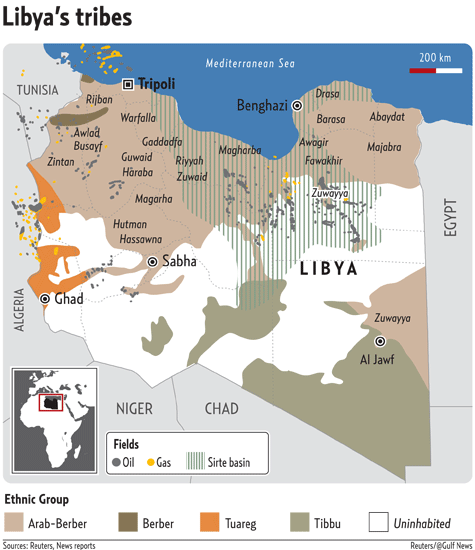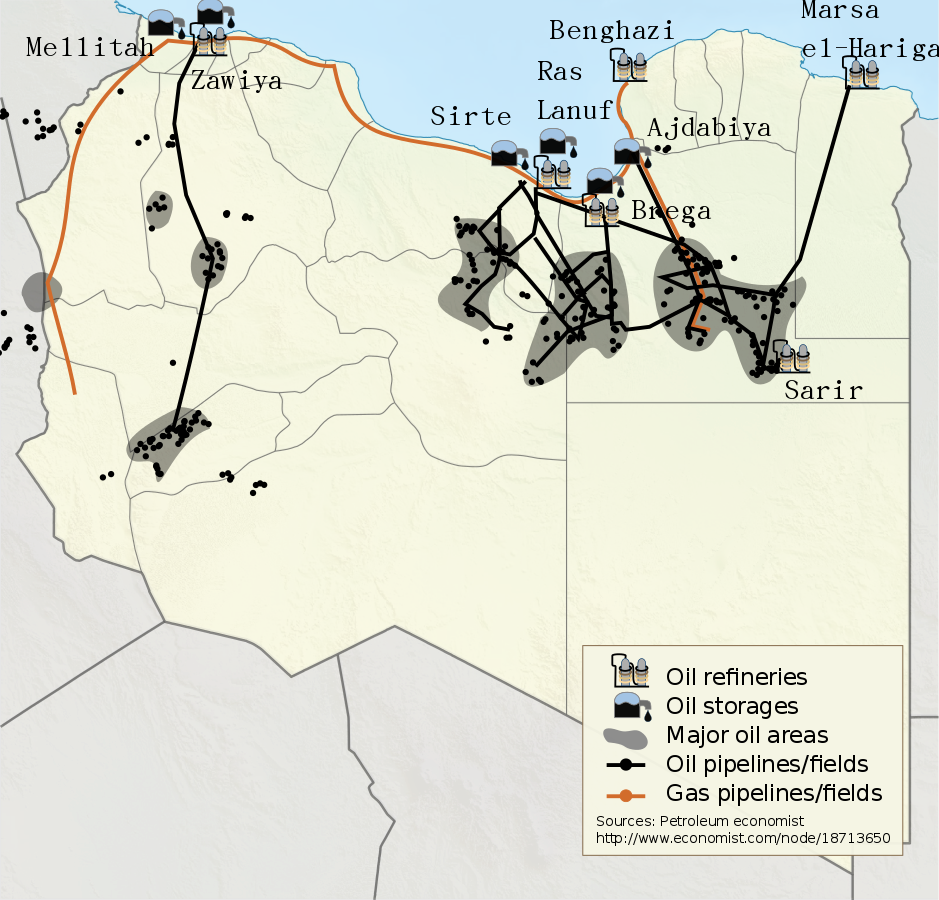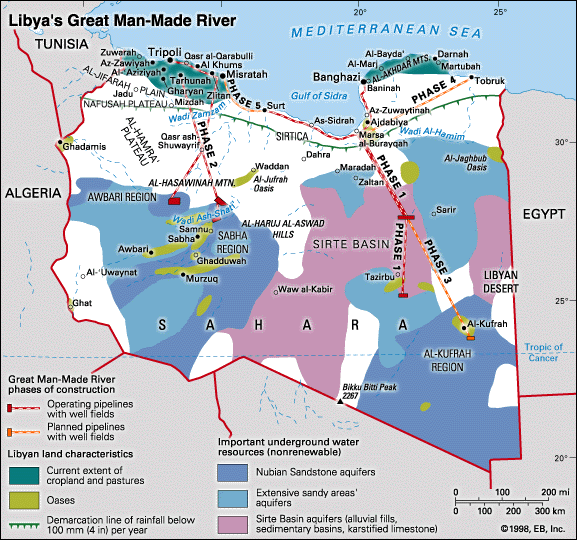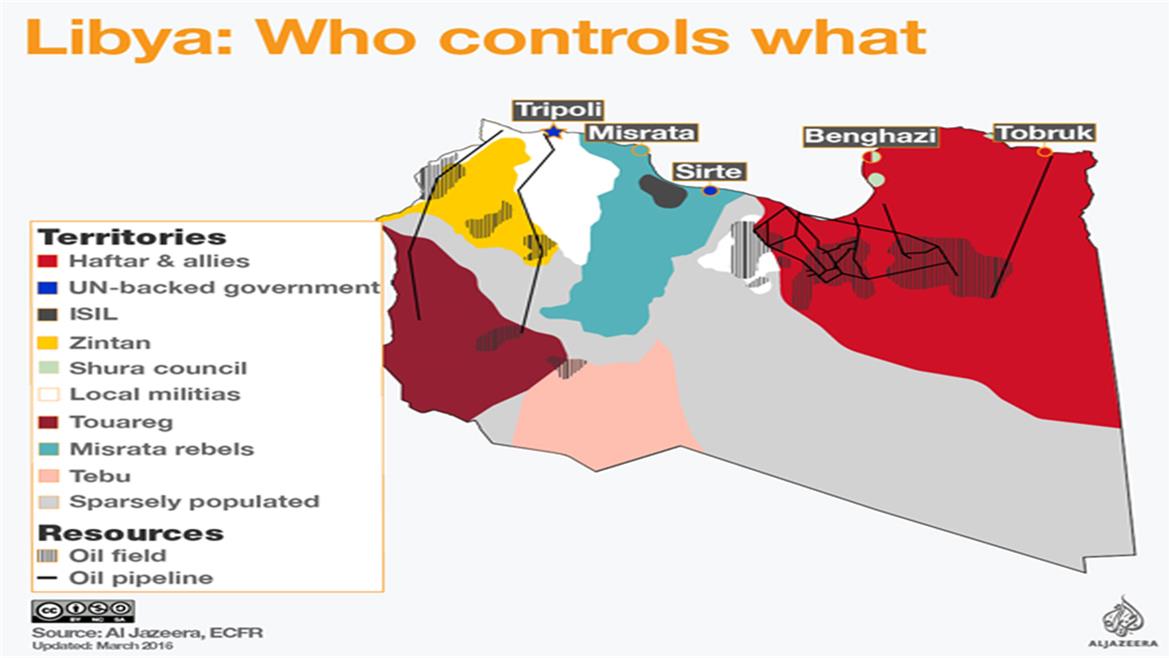
| ICE Case Studies
|
|
I.
Case Background |

Libya's domestic and international policies have long been dominated by oil. The country has virtually no other resources, outside their exclusive economic zone. Qaddafi used oil resources to promote a variety of military adventures, which usually were ill-fated adventures. He gave subsidies in exchange for friendly relations with other regional states. However, he also funded civil war in Liberia and launched a border war (see Aozou case) with Chad over a strip that contained uranium resources. He was repulsed due to French intervention. Since Qaddafi's downfall, the country has fragmented into a multi-side civil war. The countries' two major competing military factions, one based around Tripoli and the other around Benghazi, are now based on control of the two largest oil-producing parts of the country.
There were several rather fruitless attempts by Western firms at oil and gas exploration starting in the 1930s. The finds were too meager to pursue. In any event, the cost and technology of drilling in the Sahara Desert proved prohibitive. World War II put any attempts at developing and oil industry from developing. in abeyance.
Libya became an independent kingdom in 1951. At the time it was a monarchy. Oil concessions were granted to several companies in 1953 and two years later a well was successfully drilled. The timing of the renewed interest in Libyan oil coincided with questions about other oil sources for Europe. Iran was politically unstable in the early 1950s and Egypt closed the Sinai Canal in 1956. These events showed the potential weaknesses of sourcing oil in the Middle East and Libya was much closer geographically.
"Libya comprises three historical regions—Tripolitania in the northwest, Cyrenaica in the east,
and Fezzan in the southwest." (Britannica.) These regions tend to dominate the country to this day.
The Ottoman Empire treated them as separate provinces. "Under Italian rule, they were unified to
form a single colony, which gave way to independent Libya." (Britannica.) There is no historical idea for a country.
"Tripolitania and Cyrenaica were more closely linked with neighbouring territories than with one other."
Source: https://www.britannica.com/place/Libya
These regions do not however necessarily mirror the peoples who live in Libya at the current time. The country brought in many guest workers to work in support industries. Like the Gulf States, the oil income allowed them to live a high income life style.

http://gulfnews.com/news/mena/libya/tribal-divisions-could-test-the-transitional-council-1.860838
Kristen Chick, Christian Science Monitor, "Tribal divisions could test the transitional council", Gulf News LIBYAJanuary 4, 2018,
There are two major locations of Libyan oil production. The largest in the east, near Benghazi, the so-called Sitre Depression. To the west, there is also a major source south of Tripoli. Another exists much further to the south west.

By NordNordWest, Yug - File:Libya_location_map.svg by user:NordNordWestPetroleum Economist (http://www.petroleum-economist.com/), published in The Economist, The colonel feels the squeeze, May 19th 2011.Related to : File:Libyan_Uprising.svg, CC BY-SA 3.0, https://commons.wikimedia.org/w/index.php?curid=15255048
Creative Commons, Petroleum Economist (http://www.petroleum-economist.com/), published in The Economist, The colonel feels the squeeze, May 19th 2011.

Tripoli and Benghazi factions, and ISIS.
Oil has been divisive in Libyan history and has precluded the development of a sustainable economy. At the moment, with production and exports limited by instability, water is becoming more valuable than oil. Libya has a great water project that would drain historical aquifers from the interior (the Sahara Desert) and create large fresh-water rivers, even for a limited period until they run out.

https://www.britannica.com/place/Libya

Libya's economy is almost entirely dependent on oil exports. There was never an attempt under Qaddafi to diversify the economy and invest in other related industries, as many of the Gulf states have done. Libya has trouble exporting oil too. Their largest export now may be African migrants in terms of cash income.
Following the fall of Qaddafi in 2011, the country disintegrated into several competing factions that eventually consolidated into power blocks based around Tripoli and Benghazi, with ISIS allied groups controlling some areas.

"The Haftar-Sarraj Rapprochement and Prospects for a Resolution of the Libyan Crisis",
http://studies.aljazeera.net/en/positionpapers/2017/05/haftar-sarraj-rapprochement-prospects-resolution-libyan-crisis-170525101108118.html

The fall of the Libyan regime led to a huge outflow of weapons south to other countries in Africa. These weapons eventually fell into the hands of insurgent Salafist groups in the Sahel and Boko Haram. They also fueled emerging conflict between farming and ranching people. The weapons were part of the take-over of parts of Mali by Islamist groups. (see Tuareg Case)
France has a forward base of troops in West Africa to counter insurgents with these more formidable weapons acquired from Libya. The US supplies logistics and special operations forces. These forces also operate within Libya in special operations. Many Libyans joined ISIS and now with the group's defeat in Iraq and Syria, are returning to Libya and joining local ISIS groups.

Go to Ice Search Engine and Scenario Builder
